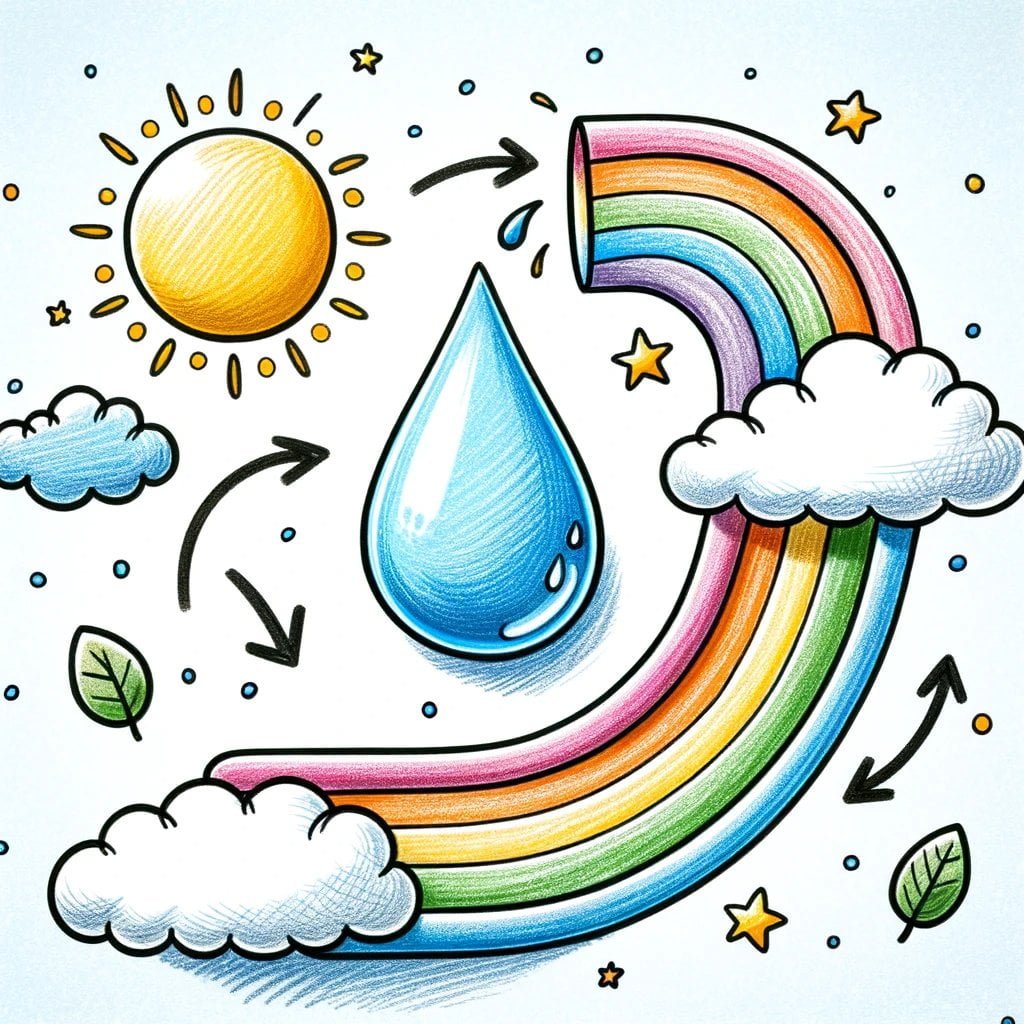Let’s dive into the world of condensation! It’s not just about water turning into tiny drops on windows. It’s a key part of the water cycle, the journey water takes from the Earth to the sky and back again. Condensation is the process that turns water vapor into clouds, fog, and dew. These droplets can change the weather, feed plants, and even create rainbows! Join us as we uncover the coolest facts about condensation and its important role in our planet’s ecosystem.
Fun Facts About Condensation and Its Role in the Water Cycle
Condensation is like a cool process that turns water vapor into liquid drops or ice crystals. It’s like when you see your breath on a cold day! That’s because your warm breath goes into the cold air and turns back into little water drops.
Clouds: Fluffy Marvels
Clouds are made up of these tiny water droplets or ice crystals that condense high up in the sky. Some clouds are so big, they reach miles high! And did you know that a single cloud droplet is about the same size as a human hair?
Condensation in Everyday Life
Condensation isn’t just a sky thing. It’s all around us!
- Foggy Mornings: Remember when you wake up to a foggy morning? That’s because the warm, moist air in the air cools down overnight and turns into fog.
- Chilly Breath: When you’re outside on a cold day and breathe out, you can see your breath because the warm air from your lungs condenses.
- Sweaty Glasses: Take a cold drink out of the fridge on a hot day, and watch the water droplets form on the outside of the glass. That’s condensation!
The Water Cycle Wizard
Condensation is a big part of the water cycle. It’s like a magical bridge between the water in our oceans and lakes and the water in our clouds. Without condensation, we wouldn’t have clouds or rain or snow.
Climate Cooler
Condensation also helps keep our planet cool. When water vapor condenses, it releases heat. This heat goes up into the atmosphere and reflects sunlight back into space, cooling us down.
So, next time you see a cloud or watch your breath on a cold day, remember the amazing process of condensation. It’s like nature’s magical trick that makes the water cycle work and keeps our planet just right for us!
Condensation, an intriguing phenomenon, is the transformation of water vapor into liquid droplets. Those interested in learning more about this fascinating process should peruse the following astounding condensation facts: You’ll be astounded by the scientific explanations for condensation’s formation on windows and its influence on weather patterns. Therefore, seize this opportunity to increase your knowledge. Click here to explore the mesmerizing world of condensation: facts about condensation.
Condensation is a vital element within the water cycle and is replete with intriguing details that are certain to astound you. It is noteworthy to mention that condensation is the transformation of water vapor into a liquid state. It occurs when warm air elevates, cools, and is no longer able to retain all the moisture. Tiny water molecules begin to form at that moment, giving rise to the aesthetically pleasing phenomenon known as clouds. Curious to know more about the condensation water cycle fun facts? Click here to dive deeper into the subject!
condensation, water cycle, fun facts
Let us now examine some interesting facts about condensation. Unbeknownst to you, condensation is an essential factor in the development of precipitation and frost. The capacity of a temperature variation to generate visually breathtaking exhibitions within our surroundings is truly remarkable. If you’re intrigued and want to uncover more intriguing details about condensation, click here!
Additionally, condensation is a fundamental component of the overall water cycle. It is a fundamental mechanism that facilitates the movement of water through the Earth’s atmosphere, ultimately resulting in its return to the surface as precipitation. To delve deeper into the water cycle and learn more about the incredible facts surrounding condensation, click here!
Water cycle condensation facts
The phenomenon of condensation within the water cycle is undeniably mesmerizing. Investigate the intriguing realm of condensation and uncover further remarkable insights by accessing the aforementioned hyperlinks. Anticipate to be mesmerized by the splendor and intricacy of this crucial component of the natural processes on our planet. Have fun exploring!
Condensation: Unraveling the Mystery of Liquid Transformation
Hold on tight as we embark on an enthralling journey into the world of condensation! This awe-inspiring process turns invisible water vapor into those tiny droplets we all know and love. But what’s the secret behind this magical metamorphosis?
Imagine a warm and humid day, the perfect conditions for condensation to flourish. As the air gets colder, it loses its ability to hold onto all that water vapor, just like how you can’t hold onto a hot cup of coffee forever. This is where the dew point comes into play. It’s the temperature at which the air can’t hold onto any more water vapor, and that’s when condensation strikes!
Just like when you pour a cold drink on a hot day and see beads of water forming on the glass, the same thing happens when warm, moist air hits something cold. The water vapor condenses, transforming into those beautiful little droplets.
The Water Cycle’s Unsung Hero
It’s no secret that condensation plays a starring role in the water cycle. Here’s how it all goes down:
- Water sizzles up from bodies like oceans and lakes, turning into water vapor and rising into the atmosphere.
- As the water vapor climbs, it gets cooler and more and more saturated with water.
- Once it reaches the dew point, condensation turns it into those fluffy clouds we love to watch.
- When the clouds get too heavy, they release rain, snow, or hail, completing the cycle.
Condensation in Everyday Life
Condensation isn’t just a scientific phenomenon; it’s something we encounter all the time! Ever noticed your bathroom mirror fogging up after a hot shower? That’s condensation in action, creating a misty veil on the glass. And when you take that frosty glass of lemonade out on a hot summer day, condensation beads up on the outside, begging you to take a refreshing sip.
Key Points for the Water Savvy
- Condensation: Water vapor transforms into liquid droplets when cooled below its dew point.
- Water cycle: Evaporation, condensation, precipitation—it’s all connected, and condensation is the middleman.
- Everyday life: From foggy mirrors to icy glasses, condensation is a constant companion.
Now, go forth and marvel at the magic of condensation, the process that brings us clouds, rain, and the fog that turns our world into a mysterious wonderland!
How does condensation contribute to cloud formation?
Have you ever wondered how those fluffy clouds in the sky form? It’s a magical process, and condensation plays a starring role!
Imagine this: you step out of a hot shower into a cool room. Suddenly, the mirror steams up as tiny water droplets form on its surface. That’s condensation in action! The same thing happens high up in the sky. As warm, humid air rises, it cools and the water vapor in the air transforms into tiny water droplets. These droplets, known as cloud droplets, are so small that they float in the air, creating a cloud.
Let’s break it down further:
- Water vapor is like an invisible gas that’s always floating around in the air.
- When the air is warm, it can hold a lot of water vapor, like a sponge that can soak up plenty of water.
- But when the air cools, it can’t hold as much water vapor, just like a sponge that can’t hold water when it’s squeezed.
- So, when the warm, moist air rises and cools, the water vapor has nowhere to go and condenses into liquid water.
- These tiny water droplets, called cloud droplets, then bump into each other and stick together, forming bigger and bigger droplets.
- Eventually, when the droplets get too heavy, they fall down as rain or snow.
And there you have it! Condensation is the magician behind cloud formation, making our skies a canvas painted with fluffy white clouds.
Fun Fact: Did you know that clouds can also form through another process called sublimation? This happens when water vapor turns directly into ice crystals, skipping the liquid water stage. It’s like when you put food in the freezer and it freezes solid without ever getting wet.
In what ways does condensation facilitate precipitation?
Imagine a world without rain, snow, or any form of precipitation. Our planet would be a barren wasteland, devoid of life. But what makes these life-giving downpours possible? Condensation—the magical process that transforms invisible water vapor into tangible droplets.
Picture this: As you exhale on a chilly morning, you see a cloud of your breath before you. That’s condensation in action. It’s the same process that causes your icy drink to gather beads of water on a hot day.
Condensation plays a pivotal role in the water cycle, the endless journey of water through our planet. It’s like the conductor of a grand orchestra, directing water vapor towards cloud formation and ultimately precipitation.
Steps to Precipitation
- Evaporation: Water from the Earth’s surface, like oceans, lakes, and even your morning coffee, evaporates into the atmosphere.
- Cooling: As the water vapor rises, it encounters cooler temperatures, like a warm breeze meeting an ice cube.
- Condensation: The chilled vapor condenses into countless tiny water droplets, forming clouds.
- Coalescence: Inside the clouds, these droplets collide and merge, becoming larger and heavier.
- Precipitation: When the droplets get too hefty for the clouds to hold, gravity takes over, and they fall back to Earth as rain, snow, hail, or sleet.
Benefits of Condensation
- Water replenishment: Condensation replenishes water supplies in various forms, rejuvenating our planet’s lifeblood.
- Climate regulation: Clouds formed by condensation help regulate our climate, shielding us from excessive heat and protecting us from harmful UV rays.
- Nutrient distribution: Precipitation brings essential nutrients from the atmosphere to the soil, nourishing plant life and supporting ecosystems.
- Natural beauty: From towering thunderclouds to gentle showers, condensation weaves a tapestry of beauty that inspires awe and wonder.
In essence, condensation is the invisible hand that orchestrates the symphony of precipitation. It transforms water vapor into clouds, clouds into rain, and rain into life itself. A testament to nature’s intricate interconnectedness, condensation is a crucial element in the delicate balance of our planet.
FAQ
Q1: What is condensation and why is it important in the water cycle?
A1: Condensation is the process where water vapor transforms into liquid water. It is a crucial part of the water cycle as it enables the formation of clouds, which produce precipitation that replenishes Earth’s water supply.
Q2: How does condensation lead to the formation of clouds?
A2: Condensation occurs when warm air containing water vapor cools and the vapor condenses into tiny water droplets. These droplets accumulate around particles in the air, forming clouds.
Q3: How do clouds contribute to the water cycle?
A3: Clouds release precipitation in the form of rain, snow, hail, or sleet. Precipitation replenishes water bodies and soil moisture, sustaining ecosystems and life on Earth.
Q4: Where else can condensation be observed aside from clouds?
A4: Condensation is visible in fog and dew formation. Fog is a cloud that forms near the Earth’s surface, while dew forms when water vapor condenses on cool surfaces like grass or car windows.
Q5: What is the significance of condensation in everyday life?
A5: Condensation plays a role in numerous processes, including:
- Air conditioning: Condensation removes excess moisture from the air, cooling indoor spaces.
- Weather forecasting: Understanding condensation helps meteorologists predict cloud formation and precipitation patterns.
- Industrial processes: Condensation is utilized in various industries, such as distilling alcohol and drying materials.
- Unveiling the Enigma: Mansoureh Khojasteh Bagherzadeh’s Public Appearances & Private Life in Iran - July 18, 2025
- Unveiling the Mystery: Mansoureh Khojasteh Bagherzadeh’s Husband: A Rare Glimpse into a Private Life - July 18, 2025
- Unveiling Masoud Khamenei’s Mother: Power, Influence, and Iran’s Future - July 18, 2025



















